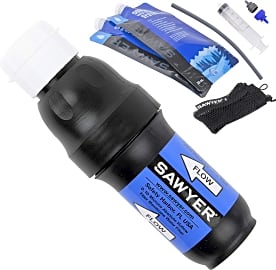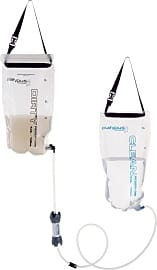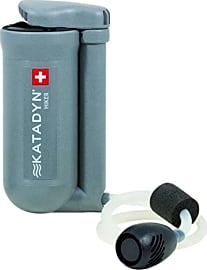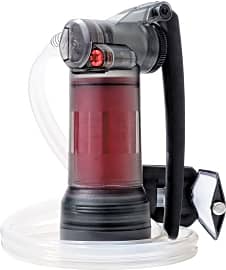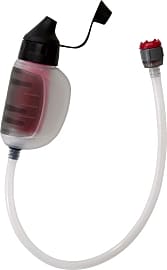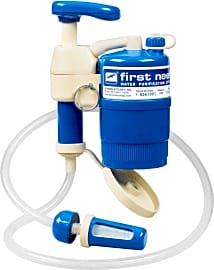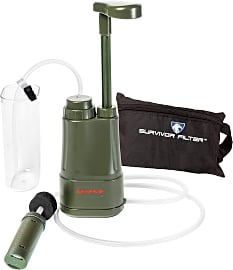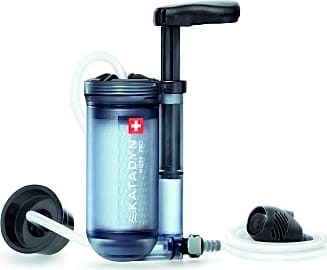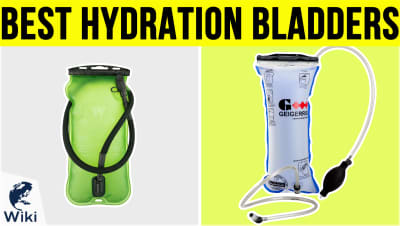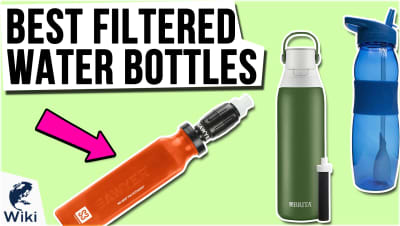The 10 Best Camping Water Filters

This wiki has been updated 38 times since it was first published in April of 2015. There's no need to lug around a bunch of heavy containers on your next outdoor excursion when you've got one of these handy camping filters. The options on this list produce safe, clean, and odor-free H2O that can be sourced from any body of fresh water, and come in both lightweight packages for the solo traveler on the go, as well as larger systems capable of hydrating whole groups of people. When users buy our independently chosen editorial choices, we may earn commissions to help fund the Wiki.
Editor's Notes
October 06, 2020:
There are a lot of water filters on the market today, so many so that it can be difficult to make an informed choice. For that matter, the one you choose will depend heavily on just how you're using it. The Katadyn Hiker Pro and Katadyn Hiker Microfilter, for example, are very good options for solo hikers, although they may not stand up to the hydration demands of large groups in the wilderness. Similarly, or perhaps even more individually focused, the Sawyer Squeeze is about as small as they come, and if all your hiking buddies are in tune with their gear, everyone having one of these can make it a breeze to refill at the creek. For that matter, the MSR TrailShot is just about as small and light as the Sawyer, but works quickly enough to accommodate a few people, in a pinch.
If you typically travel in groups, the Platypus GravityWorks is a good choice, and is almost definitely the most lauded and most efficient of the many gravity-based bladder systems available. The MSR Guardian, on the other hand, offers traditional pump action instead of a gravity feed, but its high-leverage, dual-action pump ensures that its flow rate remains especially high, and also that the element lasts as long as possible. Alternatively, the Katadyn Pocket is remarkably compact for something that works so quickly and lasts for so long. Do note, of course, that the Guardian and the Pocket both cost a considerable amount, but the trade-off is that they should last for many years without issue.
The Guardian, like the General Ecology First Need XLE, is able to remove viruses from water, which is impressive given viruses' tiny size relative to bacteria and protozoa. The Survivor Filter Pro also claims, based on independent testing, to remove essentially all viruses from most sources, and it costs considerably less than the other two similar models.
Some of these actually have direct fittings that can attach to hydration bladders, but failing that, all the non-gravity-fed models can simply be aimed into your water bottle, and they'll work just fine. Alternatively, there are quite a few quality filtered water bottles on the market, although they're definitely not ideal for long through-hikes.
April 21, 2019:
Before getting into the different sizes and functionalities of each option in our line-up of best camping water filters, rest assured that we were careful to include only those models that are proven to remove the most serious waterborne bacteria and parasites that you're likely to encounter during your next backcountry adventure. Each model should reliably clear your water of E. Coli, Giardia, crypto, and even many chemicals, such as mercury and lead. Of course, depending on how heavily contaminated the water source is, you may also want to use your filter in conjunction with more thorough methods of water treatment, such as boiling or purification solutions.
Beyond that, our list includes filtration systems that cover the full range of sizes and types, from pocket-sized straws like the Survivor 3-Stage to huge bladders like the LifeStraw Mission. Campers looking to hydrate groups of people will likely benefit from the large capacities of options like the Platypus GravityWorks, which requires no tiresome pumping to clean its H20 contents. Solo hikers and backpackers will appreciate the functionality of models like the MSR MiniWorks Ex, which screws right on to Nalgenes and wide-mouthed bladders and features a carbon core that produces clean, tasteless water. Overall, we thought the Katadyn Hiker Pro the best model for more people, since it offers reliable filtering in a durable, compact body.
Healthy Hydration In The Field: The Camping Water Filter
If you are heading out for an overnight camping trip -- or even a day hike lasting a few hours -- a reliable camping filter is a necessity.
If you are heading out for an overnight camping trip -- or even a day hike lasting a few hours -- a reliable camping filter is a necessity. The alternatives include carrying multiple liters of water along with you, greatly adding to your overall gear weight, or else facing illness caused by waterborne parasites and bacteria or dehydration and all its many unpleasant symptoms (including death at the outside extreme). You can get a water filter that will provide you with safe drinking water for very little money, or you can make a significant investment on something that's more substantial and will last longer. That elevated price tag may surprise the amateur outdoorsman, but the experienced camper/hiker will nod knowingly: when it comes to clean, safe water sourced easily and in large volumes, it's hard to worry about price.
The standard camping water filter uses a hand pump to draw water up from the source, force it through an incredibly fine filter media (usually made of ceramic) that removes all contaminants down to the one or two micron level and then through an output tube that can be placed right in your water bottle, cooking pot, cup, or even your mouth. Pump filters do require a bit of effort, but they allow you to source water from even the smallest trickling streams and giant lakes alike, and they allow the user to continually generate fresh water, whether you want only a quick cupful or multiple gallons.
The bag to bag style of camping water filters is easy to use once set up. You simply fill the elevated pouch with water collected from a pond or stream and allow gravity to bring the water down and through a filter that removes more than 99.99% of all bacteria and protozoa. The pros of these gravity operated filters include minimal effort once the first bag is filled (no repetitive pumping required) and large storage capacity: when both reservoirs are filled, you can often carry as much as four liters of water when you include the two liters yet to be purified. The drawbacks include the fact that you need to be able to elevate the system, which will in some cases mean standing there holding water aloft. You also must be able to submerge the collection bag or else have access to falling water, so some very shallow or hard to reach water sources might be difficult to use.
A third category of water filters should be thought of more as a survival tool for emergencies or as a backup filter in case the primary filter is dirtied, damaged, or simply stops working. This straw style filter is placed directly into water that is drawn up and through the purification media by suction you generate with your mouth and lungs. These filters clean hundreds of gallons of water well before needing maintenance, but they can't be used to fill bottles, cooking pots, and so forth.
Why The Water Filter Is The Best Choice
Beyond using a water filter, there are only two ways to reliably purify water while in the field. These are to boil the water, or to use chemical purifying agents. Boiling water is a time-tested way to create clean water, or at least to create water that is safe to drink. Indeed boiling water can do nothing to remove the actual debris and microscopic bacteria and parasites within the H2O, it can simply render those latter two factors inert (or, in other words, dead).
This can be an inconvenience at some times, and an impossibility at others.
To ensure that water has been boiled long enough for safety, bring it to a full rolling boil for at least one minute near sea level, and for at least three minutes at altitudes higher than 2,000 feet (the boiling point temperature of water being lower at greater altitudes). While boiling is effective, it does not remove particles as noted, and of course it necessitates the ability to create heat through a stove or fire. This can be an inconvenience at some times, and an impossibility at others.
The other method of purifying water is to use iodine tablets. Iodine kills off the bacteria and protozoa in water by actually bonding iodine ions to their pathogenic cells, preventing their ability to reproduce. Iodine treatment is effective, but it requires careful measuring of water volume to iodine tablets used, the process requires patience, and the purified water has a less than pleasant taste.
Watch Out For Wild Water
The sobering fact is that almost every natural source of water, from an apparently pristine mountain spring to a stream babbling through a meadow to a freshwater river or lake, can be harboring dangerous bacteria and parasites. Drinking untreated water -- even water that looks and tastes perfectly clear and clean -- can lead to health complications ranging from mild stomach discomfort to severe nausea and diarrhea to dangerous dehydration and lasting infection.
Fortunately, all of these pathogens will be caught by a good water filter.
The most common culprit of gastrointestinal discomfort or illness caused by drinking water from natural sources is the microscopic protozoan parasite known as Giardia lambia, more commonly called simply Giardia. This unwelcome little guest takes up residence in the upper stretches of the small intestine and causes symptoms in as many as one third of those it infects.
Most people will experience cramping, irregular bowel movements, fever, and fatigue; some people may experience these symptoms at a level of severity necessitating professional medical intervention. Giardia is a prolific problem, present in water sources all around the world. In fact, as many as five to seven percent of the population of America may be harboring the parasite at any time; as many as thirty percent of those living in the developing world may be chronically infected.
Other less common but potentially more serious water borne illnesses include cholera, typhoid, malaria, to name only a few of the maladies potentially lurking within water. If you are using melted snow as your source of hydration, be especially vigilant looking out for so-called watermelon snow. Snow with a pinkish sheen is covered with a layer of Chlamydomonas nivalis, a type of algae that thrives in cold water and that has extreme laxative properties.
Fortunately, all of these pathogens will be caught by a good water filter.


